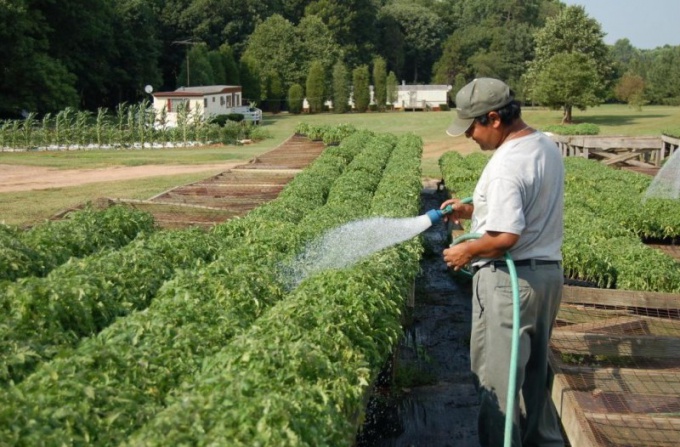You will need
- Tomatoes, pepper, water, fertilizer.
Instruction
1
Watering plants is not so easy as it may seem at first glance. It has its own characteristics and rules. Tomatoes and peppers - very heat-loving plants. They love sunlight and moisture. However, when watering aim the water so that it does not impinge on the stems and leaves. After all, under direct sunlight, the plant may get burns on wet leaves. Water use defended, and always warm. Cold water is used for hardening of plants at the stage of seedlings.
2
Watch carefully for weather conditions. In a hot and dry time watering produce every two or three days. It is advisable to water the tomatoes and peppers in the evening when the temperature goes down several degrees: the effect of watering will be longer. In hot weather, the day, the water quickly evaporates from the surface of the earth, and there is a risk to burn the roots and stems of the plant. In cold and rainy weather, keep watering to a minimum. From excess moisture the plants may suffer as well as from lack of it. From the large amount of water soil temperature sharply decreases and the humidity increases by 80-100%. Under these conditions, the flowers are pollinated worse, and ovaries are formed bad.
3
High humidity creates different diseases. So, one of them is bacterial canker of tomato. In the first stage of infection on the plant sores appear, which turn into cracks. Fungal gray or white patches (white rot) - pubescence on the type of the webs occurs in the leaves, stems and fruits. When excessive watering tomatoes become less sugar, get watery structure. In the greenhouse, warm and humid climate, the peppers and tomatoes are often affected by powdery mildew. Due to the disease fruits crack and rot. As a preventive measure against diseases is a basic ventilation of the greenhouse. In some cases it is necessary to remove the film.
4
The approximate frequency of watering the peppers and tomatoes: 2 times a week. Keep in mind that the soil should have a structure which will enable it to absorb large amounts of moisture. Method of irrigation (irrigation of plants on the very top) for peppers and tomatoes is not recommended: it has a negative impact on the growth and development of plants. Also do not use hose watering with cold tap water: it injures the roots of plants and acidic balance. Good effect on tomatoes and peppers has a watering soft rain water. Therefore, during precipitation do not forget to collect water in tanks for irrigation. Often irrigation combined with fertilizer application. So, the water for irrigation add a small amount of manure or other fertilizer according to the instructions. Frequency of fertilizer for Mature plants: 1 times a week.
5
Keep the humidity at an optimum level through mulching of the soil. On top of the ridge position remains organic: straw, compost, weeded the weeds. The layer should be about 5 cm It would slow down the evaporation of moisture, reduce weeds, maintain soil in a friable condition. Over time, organic matter decomposes, and the soil is enriched with nutrients and minerals.
Note
With insufficient watering the buds and ovaries crumble, the fruit cracks, and the stems rot affects the vertex.
Useful advice
A disease like black leg, can occur in tomato or pepper already 2 days after the overflow with water. The plant blackens at the bottom of the stalk falls to the ground and dies.
